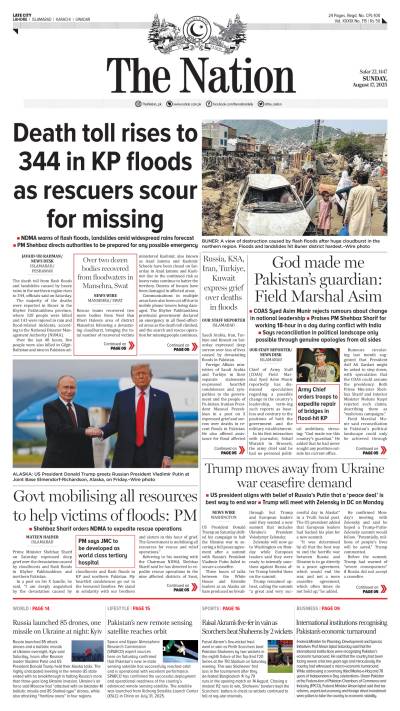The Indo-Pakistan clash of May 2025 was a magnificent display of courage, adaptability, innovation, and skill to harness the complexities and intricacies of emerging military technologies. The space, cyber, artificial intelligence (AI) domains, and the electro-magnetic spectrum have evolved to revolutionize modern warfare as decisive force multipliers. The art would be to weave them skilfully into a kill chain with modern weapon systems, well thought out, well-coordinated operational strategies and tactical plans, and by concentrating them at the right time and point of application to maximum effect. The Pakistan Armed Forces epitomized all of the above during the recent Indo-Pakistan clash! Its impact will be felt in all conflicts henceforth. It will be studied, researched, analysed, rehearsed, adopted, and perhaps improved by all the leading militaries of the world, especially those countries that have an axe to grind with China.
The art and conduct of war stand transformed.
One far-reaching geopolitical and geostrategic effect to come out of this conflict is the revitalized and reinvigorated bond between China and Pakistan. They are declared strategic partners; however, their friendship acquired phenomenal dimensions during this clash. Theirs is a wide-ranging and mutually beneficial relationship. Their militaries are acquiring the same weapon systems and multidomain capacities and capabilities. This will naturally lead to interoperability, joint operations, and the emergence of a very potent military and political alliance in the region. The strategic paradigms have changed since the clash. Pakistan and China now must seriously consider a viable, binding defence pact to secure their vital national interests in the region.
This was the first time that Western and Soviet military technologies were pitched against the Chinese in real combat. The Chinese technological advances surprised all observers as they clearly held more than just the upper hand in combat. The Western world was aghast to see one of its main weapon systems, the formidable Rafale, perform so poorly in combat. The PAF outmanoeuvred the IAF quite comprehensively. The much-vaunted Soviet S400 anti-ballistic missile system was effectively neutralized, while the storage areas of the Brahmos missiles, numerous air bases, brigade and battalion headquarters were knocked out. The results were there for the world to see, analyse, and appreciate. India’s media, information, and diplomatic offensives, based on rank fake news, disinformation, and imaginary victories, further compounded its woes. Its emissaries, on a world tour to garner support, have not met with any success whatsoever. The world has seen through PM Modi’s diabolical game plan and his crass brinkmanship. He appeared willing to risk a nuclear conflagration and massive destruction, and devastation, just to win domestic elections. It borders on the insane! PM Modi’s political future has serious question marks. Next time, there might not be enough leeway available for any meaningful intervention by the international community to forestall escalation and mutually assured destruction!
However, how will the US and its allies in the West and the Asia Pacific now view and analyse India and its military’s performance during this clash? Will India inspire any confidence in it to be entrusted with independent tasks against China in the future? India failed to overwhelm Pakistan twice, in 2019 and 2025. How can it be expected to overwhelm China, much less a very strong and possible Sino-Pakistan alliance? That leaves India very vulnerable in a tense and sensitive strategic environment. That would directly affect its pursuit of US interests, too. China, Pakistan, and India, three of the world’s most formidable military-nuclear-missile power,s have a clash of vital national interests in the larger Kashmir region. The strategic environment in Kashmir thus becomes extremely congested, sensitive, and on a nuclear hair trigger. It is the flashiest nuclear hotspot in the world! Pakistan’s Armed Forces border with the Indian Armed Forces to their western borders. Moving on, vastly advantageous interior lines of operations, they deny them the much-needed freedom of action, movement, and manoeuvre. This restricts the Indian military’s ability to shift forces from one sector to the other. Conflict in the Kashmir region can either be at the bilateral level with India taking on either Pakistan, China, or both together, or it could be India taking on China as part of the US’ grand strategy. Could both end up being dovetailed? India could be caught in a two-three-front war and would find it difficult to handle Pakistan and China simultaneously. Could it then suck in the US and its allies, at some stage? Conflict thereafter could escalate uncontrollably and assume global dimensions.
This then brings forth the deduction that the US might now feel constrained to revise its grand strategy, its hypotheses, operational strategies, and plans against China. The US might have considered enveloping China from the Pacific Ocean/South China Sea, as well as the Himalayas. India could have been entrusted with the western Himalayan flank. Is it even doable now? Are the four foundational agreements that the US so famously signed with India still operational and valid? Will the US it still pursue the same strategic objectives that it did before the Indo-Pakistan clash? Will it risk giving its F21/F35As to India, disregarding the rather ignominious fate of the Rafales? If the US intends to stick with India, then new paradigms and major changes will have to be made in their strategic alliance. India might have to jettison its notorious strategic autonomy and realistically become a subservient ally of the US. It might be offered fewer tasks, if possible.
India has emerged as the weakest link in the grand strategy to engage, envelop, contain, and manage China, much less defeat it! This will bring the QUAD and its efficacy into serious question, too. It remains to be seen how the US deals with it!
Imran Malik
The writer is a retired brigadier of the Pakistan Army. He can be reached at im.k846@gmail.com and tweets
@K846Im.







